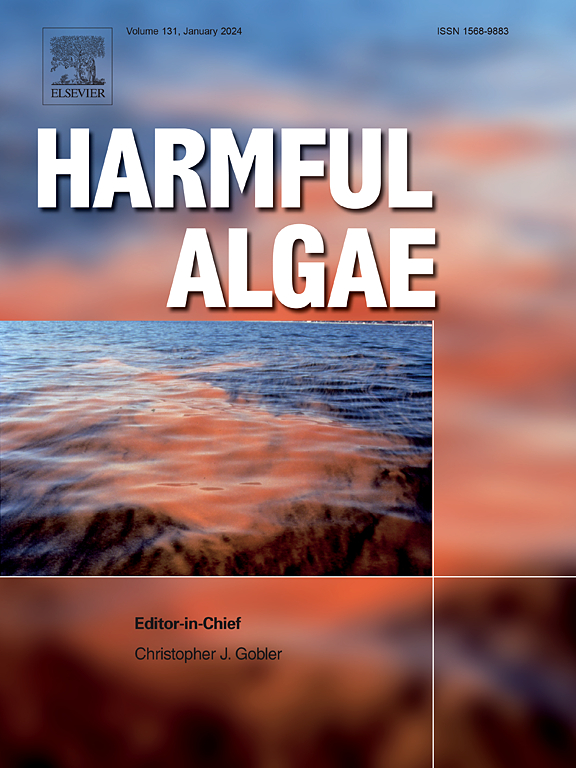无菌性和非无菌性对两类溶解有机磷酸盐的利用:对光合和溶血活性的响应
IF 4.5
1区 生物学
Q1 MARINE & FRESHWATER BIOLOGY
引用次数: 0
摘要
由于氮超载,磷是当前沿海海洋浮游植物的主要限制性营养物;然而,在沿海海洋中,有害的甲藻甲藻(Amphidinium carterae)的优势地位有所增加,这导致了A. carterae可能利用溶解的有机磷酸盐(DOP)的假设。因此,本研究对无氧和无氧黄芪进行了一系列实验,研究溶解无机磷酸盐(DIP)和两种DOP (β-甘油磷酸二钠水合盐(BGP)和2-氨基乙基膦酸(2-AEP))对黄芪光合和溶血活性的影响。结果表明,黄花蒿可以直接利用BGP (DOP的C-O-P键),但利用2-AEP (DOP的C-P键)的能力有限。低浓度的DIP (<0.36µM)降低了A. carterae的生长、生物量和光合活性;与此相反,它能诱导黄芪的溶血活性。然而,a.c arterae溶血活性的降低主要依赖于细胞分裂,而不是DIP或DOP的利用,这表明a.c arterae的生长速度与溶血活性呈显著负相关。细胞越健康(光合效率值越高),黄芪的溶血活性越低。综上所述,利用BGP的能力使a.c arterae在BGP充足的环境中成为优势,而细胞的压力,即在p有限的条件下,可能会在a.c arterae开花期间引发毒性事件。本文章由计算机程序翻译,如有差异,请以英文原文为准。
Utilization of two types of dissolved organic phosphate by axenic and nonaxenic harmful Amphidinium carterae: Response of photosynthetic and hemolytic activity
Phosphorus (P) is a major limiting nutrient of phytoplankton in the current coastal ocean due to the overload of nitrogen; however, the dominance of the harmful dinoflagellate Amphidinium carterae has increased in the coastal ocean, leading to the hypothesis that A. carterae potentially utilizes dissolved organic phosphate (DOP). Therefore, a series of experiments were conducted on axenic and nonaxenic A. carterae to investigate how dissolved inorganic phosphate (DIP) and two types of DOP (β-glycerol phosphate disodium salt hydrate (BGP) and 2-aminoethylphosphonic acid (2-AEP)) interact with the photosynthetic and hemolytic activities of A. carterae. The results showed that A. carterae could directly utilize BGP (C-O-P bonds of DOP) but had a limited ability to use 2-AEP (C-P bonds of DOP). A low amount of DIP (<0.36 µM) reduced the growth, biomass, and photosynthetic activity of A. carterae; in contrast, it induced the hemolytic activity of A. carterae. However, the reduction in the hemolytic activity of A. carterae mostly relied on cell division rather than the utilization of DIP or DOP, as indicated by the significant negative relationship between the growth rate and hemolytic activity of A. carterae. The healthier the cells (high value of photosynthetic efficiency), the lower the hemolytic activity of A. carterae. Taken together, the ability to utilize the BGP makes it possible for A. carterae to become dominant in a BGP-sufficient environment, whereas the stress of cells, i.e., in P-limited conditions, may drive toxic events during blooms of A. carterae.
求助全文
通过发布文献求助,成功后即可免费获取论文全文。
去求助
来源期刊

Harmful Algae
生物-海洋与淡水生物学
CiteScore
12.50
自引率
15.20%
发文量
122
审稿时长
7.5 months
期刊介绍:
This journal provides a forum to promote knowledge of harmful microalgae and macroalgae, including cyanobacteria, as well as monitoring, management and control of these organisms.
 求助内容:
求助内容: 应助结果提醒方式:
应助结果提醒方式:


